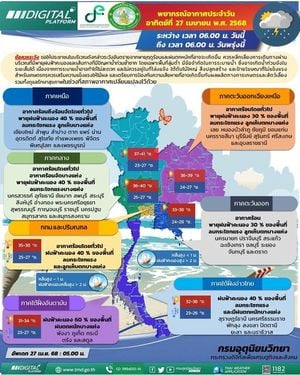India's financial markets have recently shown unusual behavior as the Nifty 50 index and the India VIX, which gauges market volatility, moved together for seven consecutive days. This phenomenon has caught the attention of market analysts, with some positing it indicates trader sentiment is shifting to less concern about substantial declines among large-cap stocks.
The Nifty 50 index has experienced notable fluctuations, seeing losses of approximately 14% from its peak last September. Concerns are mounting among investors as significant corporate earnings and economic growth metrics fail to meet expectations. The recent downward trend has prompted reviews of positions among firms, changing their approaches toward trading. Sonam Srivastava, the founder and CEO of Wright Research, commented, "The lack of hedging signifies expectations of more stability in large-cap names." This reflects growing confidence among investors as they shift to more stable investments within large-cap stocks.
Meanwhile, major institutions have reassessed their strategies with Citigroup Inc. raising its rating on Indian equities to overweight from neutral, citing, "Meaningful upside amid less demanding valuations." This sentiment was echoed by Morgan Stanley, which believes India’s stock market is poised to outperform amid improving economic conditions. With these ratings, investors may find renewed optimism as the market evolves.
Compounding the situation, the India VIX fell on the last Thursday, indicating easing fears of volatility among traders. When both the Nifty 50 and the VIX descend simultaneously, it’s often viewed as unusual, as seen last September when both indices struggled to maintain stability until the end of the year.
The synchronized movement of these two indexes is not common. Historically, such arrangements have occurred between 30% and 40% of days since the inception of the volatility measure. This marks significantly contrasting behavior when compared to the US markets, where the S&P 500 index and the Cboe Volatility Index typically move inversely about 80% of the time. Such dynamics serve as caution signs for traders when gauges fluctuate concurrently.
On Thursday, statistics reflected another drop for the Nifty 50, which saw minor decline to close flat at 22,545.05 with trading influenced by various global cues. Despite the slight decrease, analysts believe if the Nifty remains above the 22,500 mark, there could be opportunities for rebound. According to Nagaraj Shetti, Senior Technical Research Analyst at HDFC Securities, “Nifty is expected to slide down to the immediate support around the 22,400 level. Immediate resistance is placed at 22,625.” These forecasts provide traders with key levels to observe during this period of uncertainty.
The Nifty 50 futures closing above the cash market reflects continued interest among traders, even amid broader market volatility. Key components influencing this trading behavior include major financial institutions like Reliance Industries, HDFC Bank, and SBI, which have heightened activity across the futures and options segments. With March futures contracts set to expire on March 27, 2025, this could also lead to increased trading volumes and possible fluctuations.
Despite the recent bearish sentiment prevailing for the Nifty, the Bank Nifty showed some resilience, rising by 135 points to 48,744. Anshul Jain, Head of Research at Lakshmishree Investments, noted, “While the index rejected the previous day’s high, it failed to close above it, signaling caution.” The Bank Nifty's behavior underlines varied market sentiment across sectors, making it worth watching as traders adjust their strategies accordingly.
Global influences are also feeding back onto the Indian markets. Following mixed results from key figures such as Nvidia affecting wider sentiment, the Indian market remains sensitive to external economic signals, including potential tariffs on imports hinted at by U.S. President Donald Trump. Geopolitical tensions can have spillover effects, making the navigation through this period of uncertainty especially complex.
Overall, the concurrent movement of both the Nifty 50 index and the India VIX raises questions and encourages strategic repositioning among investors. Numerous financial analysts suggest this unusual correlation may represent a pivotal moment, as the market could be indicating stabilization after the turbulent trends earlier this year.
Investors are advised to remain vigilant and responsive to the dynamics observed within trading volumes and market breadth. The current trends suggest opportunities may arise as market conditions evolve, but only if key resistance levels can be breached decisively. Keeping tabs on institutional opinions and market indicators such as the VIX may provide valuable insights as investors traverse through this period of uncertainty.



